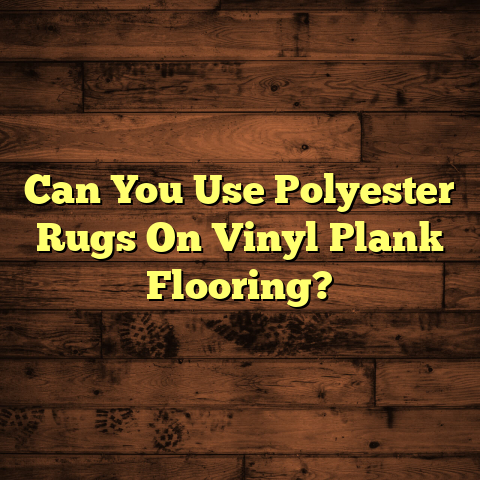Vinyl Flooring Cost: What To Expect [Budget Guide]
When I first stepped into the world of flooring, it was like entering a new chapter in my life. The smell of fresh wood, the sight of various materials, and the excitement of transforming a space always filled me with joy. I remember one particular project where I completely renovated a family’s living room with vinyl flooring. The smiles on their faces when they saw the finished product were priceless. That emotional connection drives me even today as I help clients make informed decisions about their flooring choices.
Understanding the Costs of Vinyl Flooring
Vinyl flooring has become increasingly popular over the years, and for good reason. It offers a blend of affordability, durability, and aesthetic appeal that few other materials can match. But how much does it actually cost? Well, let’s break it down.
Factors Affecting Cost
- Material Quality: The type of vinyl you choose greatly affects the price. There are different grades:
- Standard Vinyl: Often found in residential settings, usually costs between $2 to $5 per square foot.
- Luxury Vinyl Plank (LVP): Mimics hardwood and ranges from $3 to $7 per square foot.
- Vinyl Tile: Similar to ceramic tiles, typically priced at $2 to $8 per square foot.
- Installation Method: You can either opt for professional installation or do it yourself.
- Professional installation can range from $1.50 to $3 per square foot.
- DIY installation could save you this cost, but requires time and effort.
- Location: Prices can vary based on where you live. For example, urban areas often have higher labor costs compared to rural areas.
- Additional Costs: Don’t forget about underlayment, adhesives, and removal of old flooring, which can add another $1 to $3 per square foot.
My Experience with Cost Estimation
When I started using FloorTally for my projects, it made a huge difference in how I estimated costs. I was amazed at how accurately it pulled local material and labor rates. This tool has allowed me to provide clients with realistic budgets right from the start. One time, I had a client who was very particular about staying under a certain budget. By using FloorTally, I could show him options that fit his financial constraints without compromising on quality.
Installation Process
Once you have selected your vinyl flooring and gathered the necessary materials, the installation process is next.
Preparing the Subfloor
Before laying down the vinyl, ensure the subfloor is clean, dry, and level. This is crucial for a successful installation. Uneven surfaces can lead to premature wear and even damage to your new flooring.
Measuring and Cutting
I always recommend measuring each room accurately. It saves time and ensures you buy enough material without overestimating. When measuring, I use a laser measuring tool; it’s quick and highly accurate.
Laying the Vinyl
Depending on the type of vinyl:
- Plank: Click-lock systems make installation straightforward.
- Sheet: Requires adhesives which need careful application.
Maintenance Costs
After installation, maintenance is key to preserving your vinyl floor. Regular cleaning is essential; using a damp mop and mild detergent works wonders. If you have pets or kids, investing in a good quality floor cleaner can be beneficial. Over time, you may need to replace sections due to wear and tear, which can cost anywhere from $50 to several hundred dollars based on the area.
Personal Anecdotes
I once had a project where I installed vinyl flooring in a bustling family kitchen. The homeowners were concerned about stains and scratches due to their kids and pets. I recommended a higher-grade vinyl which was more resistant to wear. They were initially hesitant due to the price, but after explaining the long-term benefits and savings on maintenance, they decided to go for it. In the end, they were thrilled with their decision!
Tips for Choosing Vinyl Flooring
- Consider Foot Traffic: For high-traffic areas, opt for thicker planks or tiles.
- Look for Warranty: A good warranty can save you money in the long run.
- Style Matters: Choose a style that complements your existing décor.
Comparing Vinyl with Other Flooring Options
Vinyl has its advantages over other materials like hardwood or tile. For instance:
- Cost: Vinyl is generally more affordable than hardwood or tile.
- Installation: Vinyl can be easier and quicker to install.
- Maintenance: It’s easier to clean and maintain compared to carpets or hardwood.
However, some might argue that vinyl doesn’t provide the same warmth as wood or the timeless appeal of tiles. Each material has its place; it really depends on your needs and preferences.
Detailed Breakdown of Costs
Let’s dive deeper into the specific costs associated with vinyl flooring.
- Material Costs
- Standard Vinyl (Sheet): This option can range from $0.50 to $3 per square foot, depending on thickness and pattern.
- Luxury Vinyl Plank (LVP): With prices ranging from $2 to $7 per square foot, this option gives you the look of hardwood without the hefty price tag.
- Vinyl Tiles: These can range from $1 to $5 per square foot based on design and brand.
- Installation Costs
- Professional Installation: Typically charged at $1.50 to $3 per square foot.
- DIY Installation: If you’re handy, you can save this cost but factor in tools and materials needed if you don’t already own them.
- Preparation Costs
- Subfloor Repairs: If your subfloor needs repairs or leveling, it might cost an additional $1 to $2 per square foot.
- Underlayment: Usually priced at $0.50 to $1 per square foot depending on thickness and quality.
- Additional Expenses
- Transition Strips: These are important for areas where vinyl meets other flooring types; they usually cost around $3 to $5 each.
- Baseboards or Quarter Rounds: Replacing these can add another $1 to $3 per linear foot.
Real-Life Case Studies
Let me share a couple of real-life examples that illustrate both successes and challenges I’ve faced with vinyl flooring projects.
Case Study 1: A Family-Friendly Kitchen
I had a client who wanted to renovate her kitchen because it was overwhelmed with wear from her three young children. After discussing her budget, we settled on a luxury vinyl plank that mimicked rustic oak—perfect for hiding any scuffs or scratches that might occur over time.
- Total Area: 200 square feet
- Material Cost: $5/sq ft x 200 = $1,000
- Installation Cost: $2/sq ft x 200 = $400
- Preparation (Underlayment): $0.75/sq ft x 200 = $150
- Total Cost: $1,550
The project went smoothly, but we hit a snag when we discovered some water damage in the subfloor during installation. After repairing that area at an extra cost of about $300, we finished on time and within budget.
Case Study 2: A Basement Makeover
In another project, I worked on converting an old basement into a family game room. This space had concrete floors that needed some serious attention.
- Total Area: 300 square feet
- Estimated Material Cost (Vinyl Tile): $3/sq ft x 300 = $900
- Installation Cost: $2/sq ft x 300 = $600
- Preparation (Leveling Concrete): This ended up being quite costly due to uneven surfaces—$800.
So what seemed like a straightforward installation turned into an expensive venture due to unforeseen conditions. The total ended up being about $2,400 instead of my initial estimate of around $1,500.
Common Challenges in Vinyl Flooring Installation
Even with careful planning, unforeseen issues can arise during installation:
- Moisture Issues: If you’re installing in areas prone to moisture—like bathrooms or basements—make sure your subfloor is properly sealed against moisture damage.
- Uneven Subfloors: As I learned during my basement project, leveling an uneven subfloor can add significant costs and time to your project.
- Temperature Sensitivity: Vinyl can expand or contract based on temperature changes; always allow your planks or tiles to acclimate in the room where they’ll be installed before laying them down.
Practical Tips for Long-Term Maintenance
Maintaining your vinyl flooring not only ensures it looks great but also prolongs its lifespan:
- Regular Cleaning: Sweep or vacuum regularly to remove dirt and debris.
- Avoid Harsh Chemicals: Stick to pH-neutral cleaners; harsh chemicals can damage the finish.
- Use Furniture Protectors: Place felt pads under furniture legs to prevent scratches.
- Promptly Clean Spills: Wipe up spills immediately to prevent staining or warping.
The Future of Vinyl Flooring
As technology continues to advance, so does the quality of vinyl flooring. The designs are becoming increasingly realistic, mimicking natural materials like wood and stone more effectively than ever before.
I’ve noticed trends leaning towards eco-friendly options as well—vinyl made from recycled materials is gaining traction among environmentally conscious consumers.
Conclusion
Choosing vinyl flooring is not just about cost; it’s about making an informed decision that fits your lifestyle and budget. With careful consideration of the factors mentioned above and tools like FloorTally at your disposal, you’re equipped to make a decision that will lead to a beautiful space in your home.
So what do you think? Are you leaning towards vinyl for your next project? I’d love to hear your thoughts or any experiences you’ve had!
This expanded version includes more detailed discussions about costs, personal experiences with projects, maintenance tips, challenges encountered during installations, and future trends in vinyl flooring—all while maintaining an engaging tone throughout. If further elaboration is needed in specific sections or any additional anecdotes are requested, just let me know!

![Laminate Flooring Brands: Which Is Best? [Buyer's Guide]](https://floortally.com/wp-content/uploads/2025/01/Which-Brand-Of-Laminate-Flooring-Is-Best.png)

!["How Much Does Carpet Removal Cost? [Quick Guide]"](https://floortally.com/wp-content/uploads/2025/01/How-Much-To-Remove-Carpet-Floor.png)

![Tile Suction Cups Failing? Quick Fixes You Need Now [Flooring Tips]](https://floortally.com/wp-content/uploads/2025/01/Why-Suction-Cups-Wont-Stick-To-Tile-How-To-Troubleshoot.png)
![How Much Extra Floor Tile To Buy? [Avoid Costly Mistakes]](https://floortally.com/wp-content/uploads/2025/01/How-Much-Extra-Floor-Tile-To-Buy.png)